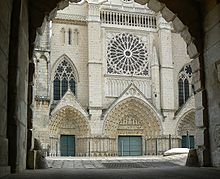
Cathedral of Saint Peter, Poitiers
Encyclopedia

Poitiers
Poitiers is a city on the Clain river in west central France. It is a commune and the capital of the Vienne department and of the Poitou-Charentes region. The centre is picturesque and its streets are interesting for predominant remains of historical architecture, especially from the Romanesque...
, France
France
The French Republic , The French Republic , The French Republic , (commonly known as France , is a unitary semi-presidential republic in Western Europe with several overseas territories and islands located on other continents and in the Indian, Pacific, and Atlantic oceans. Metropolitan France...
. It is the seat of the Bishop of Poitiers.
Its construction began in 1162 by Henry II of England
Henry II of England
Henry II ruled as King of England , Count of Anjou, Count of Maine, Duke of Normandy, Duke of Aquitaine, Duke of Gascony, Count of Nantes, Lord of Ireland and, at various times, controlled parts of Wales, Scotland and western France. Henry, the great-grandson of William the Conqueror, was the...
and Eleanor of Aquitaine
Eleanor of Aquitaine
Eleanor of Aquitaine was one of the wealthiest and most powerful women in Western Europe during the High Middle Ages. As well as being Duchess of Aquitaine in her own right, she was queen consort of France and of England...
on the ruins of a Roman basilica
Basilica
The Latin word basilica , was originally used to describe a Roman public building, usually located in the forum of a Roman town. Public basilicas began to appear in Hellenistic cities in the 2nd century BC.The term was also applied to buildings used for religious purposes...
, and work was well advanced by the end of the 12th century. It is the largest medieval monument in the city of Poitiers.
It is built in the Romanesque
Romanesque architecture
Romanesque architecture is an architectural style of Medieval Europe characterised by semi-circular arches. There is no consensus for the beginning date of the Romanesque architecture, with proposals ranging from the 6th to the 10th century. It developed in the 12th century into the Gothic style,...
and Early Gothic
Gothic architecture
Gothic architecture is a style of architecture that flourished during the high and late medieval period. It evolved from Romanesque architecture and was succeeded by Renaissance architecture....
styles, the latter predominating. It consists of three nave
Nave
In Romanesque and Gothic Christian abbey, cathedral basilica and church architecture, the nave is the central approach to the high altar, the main body of the church. "Nave" was probably suggested by the keel shape of its vaulting...
s almost equal in height and width, all three of which decrease towards the west, thus enhancing the perspective. Its length is 308 ft., and the keystone of the central vaulted roof is 89 ft. above the pavement. There is no apse
Apse
In architecture, the apse is a semicircular recess covered with a hemispherical vault or semi-dome...
, and the exterior generally has a heavy appearance. The principal front, which is broad relative to its height, has unfinished side-towers 105 and 110 ft. tall, begun in the 13th century.
Most of the windows of the choir and the transept
Transept
For the periodical go to The Transept.A transept is a transverse section, of any building, which lies across the main body of the building. In Christian churches, a transept is an area set crosswise to the nave in a cruciform building in Romanesque and Gothic Christian church architecture...
s preserve their stained glass of the 12th and 13th centuries; the end window, which is certainly the first in the order of time, contains the figures of Henry II and Eleanor. The choir stalls, carved between 1235 and 1257, are among the oldest in France.
External links
- Cathedral exterior, and external view of one of the numerous churches in Poitiers
- Cathedral interior

